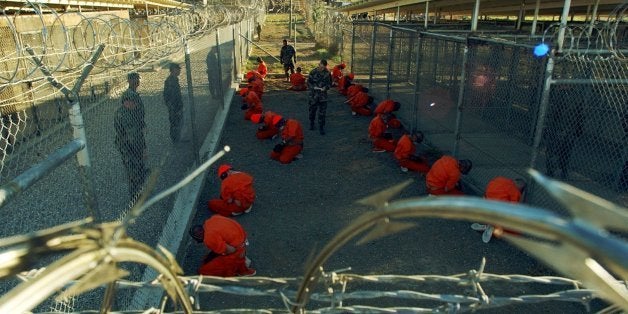
WASHINGTON -- One year ago Friday, the Senate Intelligence Committee, then under the command of Sen. Dianne Feinstein (D-Calif.), voted to share with the world some of Washington’s most tightly held secrets: gruesome accounts of CIA personnel torturing detainees for the good of all Americans -- who had little idea what was being done in their name.
After a protracted battle with both the CIA and the White House over how much information to release, the executive summary of Feinstein’s massive torture report finally saw the light of day in early December. Its release did not set off a violent backlash overseas despite panicked warnings from the intelligence community, nor did it irrevocably damage U.S. national security. It didn’t sit well with the American public either, who saw headlines about rectal feeding and sodomization for weeks.
But months later, human rights advocates and intelligence community observers point out, the public revelations haven’t fundamentally changed America’s conversation about torture.
The CIA still won’t label as torture the harsh interrogation techniques it embraced in the aftermath of 9/11 and refuses to concede that they probably didn’t help produce any valuable intelligence. Despite the repeated abuses detailed in the study, the U.S. government has declined to clearly label the actions as illegal or hold anyone accountable. In the days after the report summary’s release, a majority of Americans continued to believe the CIA’s actions were justified. The director of the FBI, the nation’s leading law enforcement agency, recently told Congress that he didn’t really think the bureau could learn anything from the torture report. And as of late January, the departments of State and Justice still hadn’t opened their sealed copies of the full report -- neither would tell HuffPost whether that has changed since, saying the matter related to pending litigation.
The lack of progress makes for a staggeringly skewed equation. On paper, the torture report adds up to 6,900 pages of painstaking research. Behind those pages are millions of documents and six years of work by Senate Intelligence Committee staffers, led by the report’s primary author, staffer Daniel Jones. More than 40 million taxpayer dollars were spent, largely because of all the hoops the CIA made investigators jump through. And yet the U.S. seems to have little to show for it.
“We certainly have not systematically learned enough. We’ve continued to try and redact our way out of our past mistakes, classify our way out of our past mistakes,” said Mark Fallon, a former military counterintelligence officer who specializes in interrogation. “Most people don’t even know what the lessons were to learn.”
Fallon and several other former military intelligence officers, human rights activists and torture watchers had mixed feelings when asked to reflect on the past year of political battles and horrifying revelations. While some were optimistic that progress will yet be made, all were united on this: The U.S. is still not as far removed from torture as it should be.
“We’ve learned a lot, but there’s still a lot more to learn and we haven’t really made any changes,” said Katherine Hawkins, a national security fellow at the transparency group OpenTheGovernment.org and a former investigator for the Constitution Project’s Task Force on Detainee Treatment, which produced its own report on the torture program. “The U.S. government has not taken seriously its obligation under the [United Nations] Convention Against Torture to hold officials accountable for torture. There were crimes. And not only have there been no prosecutions, but the government has refused to give a straight answer about why the investigations failed.”
Feinstein, now the Senate Intelligence Committee's ranking member, has often said the report's chief purpose was to serve as a deterrent to ensure that the U.S. would never again head down that dark path. By documenting the horrors committed -- and the lack of valuable intelligence to show for it -- the report was supposed to convince Americans that torture doesn’t pay.
But Feinstein’s message doesn't seem to have reached the deep corners of the intelligence world.
“From my time in the military, I can tell you there are people who would love to get back into coercive interrogation. I don’t know if they rationalize that it works and that’s why they love doing it, or they love doing it and that’s why they rationalize that it works,” said Steve Kleinman, a recently retired career military intelligence officer. “We are one attack away from returning [to it]. ... The safeguards aren’t even close to being in place.”
The limited impact of the torture report has been disappointing, said one former Hill staffer familiar with the report. (He asked not to be identified due to the sensitivity of his prior work.) People who were against torture are still against it, the staffer said, and people who defended torture are still defending it. He suggested the report may even have emboldened torture’s defenders.
Meanwhile, the Obama administration still has not taken a clear legal stance on the post-9/11 torture program. The White House has said that the CIA's actions amounted to torture and that torture, generally speaking, is illegal. But top officials have refused to say whether the agency’s efforts broke national or international law.
The White House declined to comment further.
The Justice Department has punted on any further investigation of the CIA’s actions in the aftermath of the torture report. An inquiry headed by Assistant U.S. Attorney John Durham concluded in 2012 that there was insufficient evidence to bring charges against U.S. interrogators in the deaths of two detainees held overseas. The U.S. government has frequently touted that investigation as proof that it takes torture seriously.
The international community, though, has strongly criticized the Durham effort, saying it failed to comprehensively examine the allegations against U.S. interrogators. Many outside the U.S. hoped the torture report would inspire a new criminal investigation. Those hopes were dashed when the Justice Department said it found nothing requiring another look in the report.
It’s unclear how that determination was reached given the government’s claims that the Justice Department had not even opened its copy of the full report. The department declined to comment or clarify.
Post-report, however, several other countries have opened inquiries to examine the legality of the CIA’s actions and their own complicity in them.
Lithuania’s prosecutor general announced Thursday that the office would reopen a dropped investigation into the interrogations that allegedly took place at a CIA black site in that country. The office told Reuters that the renewed interest was sparked by the release of the executive summary in December.
In February, the European Court of Human Rights refused to reconsider its ruling on a CIA black site operated in Poland, thereby requiring that country to prosecute Polish officials who were in the loop.
In March, 21 groups from around the world issued a call to the United Nations Human Rights Council to pursue "full accountability and transparency” on the U.S. torture program. The U.N. Committee Against Torture -- to which the United States is a party -- had previously slammed Washington for failing to investigate or properly atone for the CIA’s actions.
The U.S. has continued to resist that U.N. criticism, and it’s unclear what effect the European rulings will have in the U.S., including on any possible prosecution of CIA officers.
But some human rights advocates remain hopeful that the public release of the torture report summary has begun a critical, if slow-moving, shift in America’s torture conversation.
“I don’t think that’s the end. I think the reverberations from the report are still being felt. There’s still room for action. There’s still time for them to really digest it and have a more thorough reaction to what’s in there,” said Laura Pitter, senior national security counsel at Human Rights Watch. “They might want it to go away, but it’s not going to go away.”

